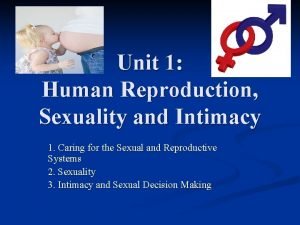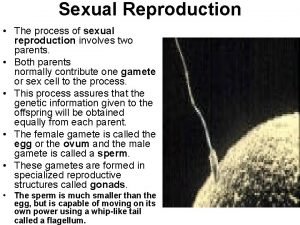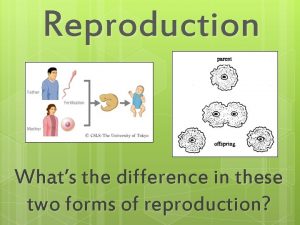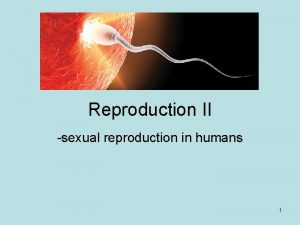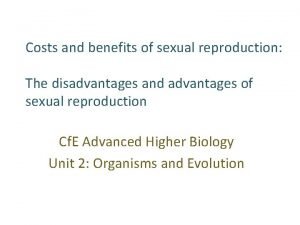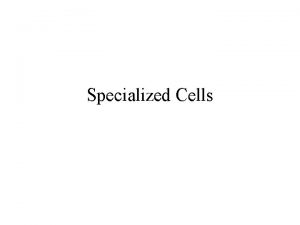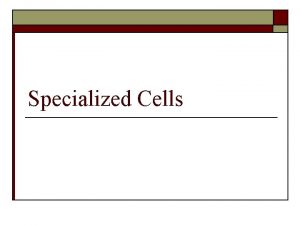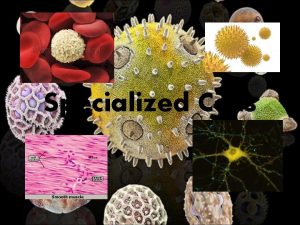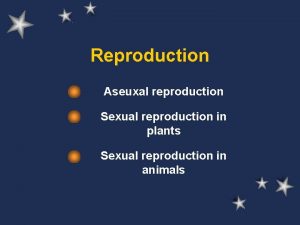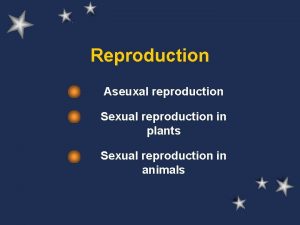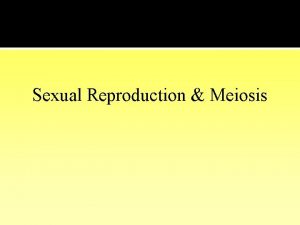Sexual Reproduction each organism has specialized sex cells



















- Slides: 19

Sexual Reproduction – each organism has specialized sex cells (and egg or a sperm) **these specialized sex cells only have 23 chromosomes**

Diploid: cells with pairs of chromosomes (46) Haploid: cells with single chromosomes (23)

SEXUAL REPRODUCTION • Fertilization is when a sperm and egg cell meet.

SEXUAL REPRODUCTION • Half of genes come from each parent • Produces genetically different offspring

SEXUAL REPRODUCTION Advantages Disadvantages • Genetic diversity • Organisms can adapt to change • Requires 2 individuals • Takes more energy • Takes a long time

SEXUAL REPRODUCTION During sexual reproduction each parent produces sex cells which contain half the number of chromosomes as the parent’s body cell

Homologous chromosomes – chromosomes that carry the same sets of genes (forms the X shape of a chromosome) Homologous Chromosomes • 1 from mother, 1 from father • Each cell gets one or the other


MEIOSIS Diploid Haploid Diploid

23 & Me Meiosis: a process in which one diploid cell divides to make 4 haploid sex cells

PAGE 416 • 2 colors for chromosomes • 1 maker for cell membrane • 1 color for nucleus • 1 color for cytoplasm Labels: • Chromosomes • Nucleus Description for each stage on the back

Steps of Meiosis I Prophase I Pairs of homologous chromosomes allow for crossing over – genetic material shuffling Metaphase I Paired chromosomes line up at equator Anaphase I Homologous chromosome pairs separate Telophase I Nucleus reforms, chromatid pairs still joined

Steps of Meiosis I Metaphase I Paired chromosomes line up at equator Anaphase I Homologous chromosome pairs separate Telophase I Nucleus reforms, chromatid pairs still joined

Steps of Meiosis I Anaphase I Homologous chromosome pairs separate Telophase I Nucleus reforms, chromatid pairs still joined

Steps of Meiosis I Telophase I Nucleus reforms, chromatid pairs still joined

Steps of Meiosis II (basically mitosis) Anaphase II Chromatids pull apart Prophase II Each cell has one member of each chromosome pair; chromos. not copied between divisions Telophase II 4 new cells have formed; each new cell has half number of chromos. as original

Steps of Meiosis II (basically mitosis) Anaphase II Chromatids pull apart Metaphase II Chromos. line up at equator of cell Telophase II 4 new cells have formed; each new cell has half number of chromos. as original

Steps of Meiosis II (basically mitosis) Anaphase II Chromatids pull apart Telophase II 4 new cells have formed; each new cell has half number of chromos. as original

Steps of Meiosis II (basically mitosis) Telophase II 4 new cells have formed; each new cell has half number of chromos. as original
 Reproduction in organism
Reproduction in organism The disadvantages of sexual reproduction
The disadvantages of sexual reproduction Hare lynx
Hare lynx Sexual and asexual reproduction in animals venn diagram
Sexual and asexual reproduction in animals venn diagram Sex sex sex
Sex sex sex Sex snv
Sex snv Xxtesticles
Xxtesticles Sex sex sex
Sex sex sex Secondary sexual characters
Secondary sexual characters Chapter 8 cellular reproduction cells from cells
Chapter 8 cellular reproduction cells from cells Yellowstone food web answer key
Yellowstone food web answer key Sexual reproduction in human
Sexual reproduction in human Chapter 20 sexual reproduction in animals
Chapter 20 sexual reproduction in animals What is sexual reproduction
What is sexual reproduction Define sexual reproduction
Define sexual reproduction Sexual reproduction and genetics section 1 meiosis
Sexual reproduction and genetics section 1 meiosis Whats reproduction
Whats reproduction Reproduction in humans
Reproduction in humans Chapter 10 sexual reproduction and genetics
Chapter 10 sexual reproduction and genetics Sexual or asexual reproduction
Sexual or asexual reproduction











